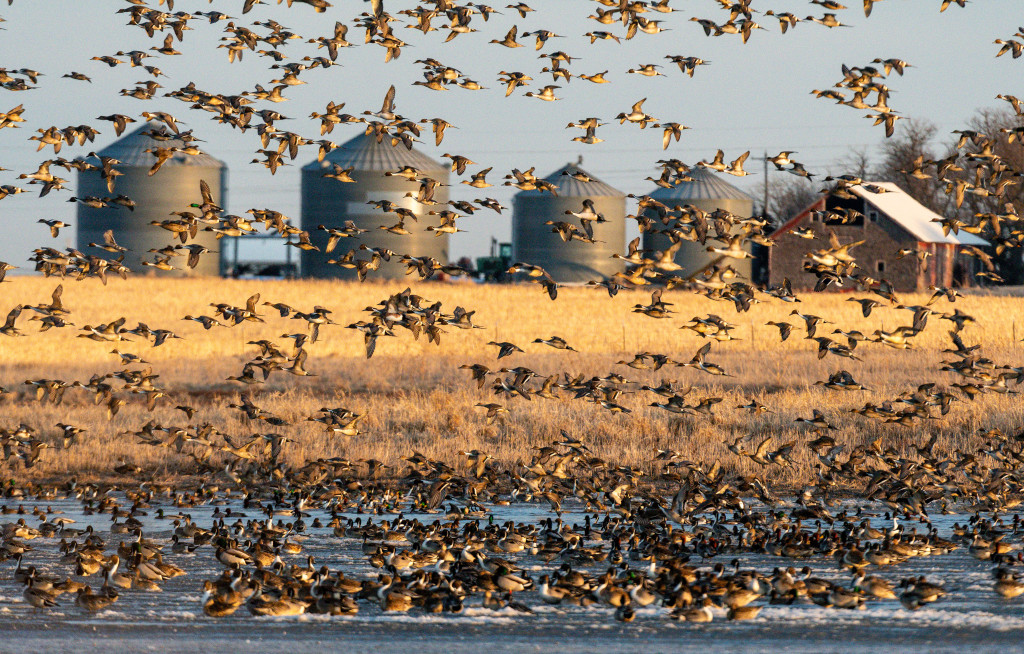In March, the millions of ducks that move through Nebraska are just as impressive as the gathering of sandhill cranes.
Enlarge

Photo by Eric Fowler, Nebraskaland Magazine
By Eric Fowler
When it comes to birdwatching in Nebraska in March, sandhill cranes get most of the love. But many don’t realize that a few miles south of the Platte River in the Rainwater Basin there is an equally impressive gathering of millions of ducks.
The Rainwater Basin includes nearly 400 wetlands, ranging in size from a few to more than 1,000 acres, scattered across 21 counties in south-central Nebraska that provide critical habitat for migratory birds. Of those, 93 are U.S. Fish and Wildlife Service waterfowl production areas and Nebraska Game and Parks Commission wildlife management areas open to the public for wildlife viewing and photography in the spring.
Moist-soil plants like smartweed and barnyard grass sprout from the clay soils in or on the edge of these shallow, seasonal playa wetlands. When water floods that vegetation, waterfowl feast on the seeds and loaf and rest in the cover it provides. They also feed on abundant invertebrates and plant tubers in and around the water.
An estimated 8.6 million ducks and geese and 600,000 shorebirds stop here each spring. That includes 50 percent of the mid-continent snow goose populations, half of the mid-continent population of mallards and 30 percent of the continent’s northern pintails.
As far as the ducks go, Jeff Drahota, a wildlife biologist with the U.S. Wildlife Service Rainwater Basin Wetland Management District, said every species of duck found in the flyway, including divers like redheads, will stop in the Rainwater Basin for a few days or a week, depending on habitat conditions, to refuel for their northward migration. Mallards show up first, typically in mid- to late February, followed by pintails. Medium-sized ducks like gadwalls are next, and smaller ones like green-winged teal arrive last. The timing of their arrival depends on the weather in the region, as the birds follow the spring thaw northward, waiting for wetlands to thaw and snow to melt before arriving. Likewise for their departure.
“In terms of the best time to see the most species is probably in that middle of March to the end of March,” Drahota said. “If you want to see the most ducks, it’s probably that peak of migration, which tends to occur a week or two after the snow geese show up.
“So if you want to see mass amounts of pintails, you’ve got to be fairly early but you’re not going to see a whole lot of other species.”
When the migration is at its peak and food and water are plentiful, Drahota noted you might find 5,000 to 10,000 ducks per acre on these wetlands, with numbers on a single marsh approaching 500,000. Although they are at times hidden from sight, feeding beneath flooded vegetation, he has seen wetlands holding so many ducks “you couldn’t see the water.”
Plenty of geese might also be in the basins when duck migration peaks, with the occasional mass of up to 1 million snow geese using a single wetland.
In any given year, where ducks are found will depend on where there is water. In dry years, water will be pumped into certain wetlands to ensure habitat is available. That may be the case this spring, as drought left most basins dry last fall. Find which wetlands are pumped in the “wetland habitat conditions report” at OutdoorNebraska.gov.
Three recommended areas have viewing decks or towers: Funk and Massie WPAs and Ducks Unlimited’s Verona Complex. Father Hupp WMA has a waterfowl blind that is open to birdwatchers. And Lake Seldom on the edge of Holdrege has a hiking trail on the west side. Many other wetlands are bisected or bordered by roads and typically offer good viewing opportunities; they include: Clark, Gleason, Harvard, Hultine, Johnson and Smith WPAs and Greenhead, Kissinger Basin, North Lake Basin, Sacramento-Wilcox, Sora and Straightwater WMAs.
 Nebraskaland Magazine
Nebraskaland Magazine


